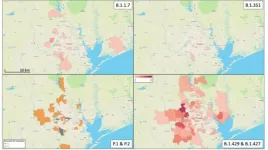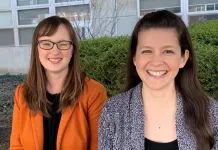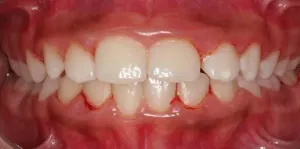(Press-News.org) Researchers have found a long-sought enzyme that prevents cancer by enabling the breakdown of proteins that drive cell growth, and that causes cancer when disabled.
Publishing online in Nature on April 14, the new study revolves around the ability of each human cell to divide in two, with this process repeating itself until a single cell (the fertilized egg) becomes a body with trillions of cells. For each division, a cell must follow certain steps, most of which are promoted by proteins called cyclins.
Led by researchers at NYU Grossman School of Medicine, the work revealed that an enzyme called AMBRA1 labels a key class of cyclins for destruction by cellular machines that break down proteins. The work finds that the enzyme's control of cyclins is essential for proper cell growth during embryonic development, and that its malfunction causes lethal cell overgrowth. Moreover, the study further suggests that an existing drug class may be able to reverse such defects in the future.
As in a developing fetus, restraints on cell division are central to the prevention of abnormal, aggressive growth seen in cancers, and the new study finds that cells have evolved to use AMBRA1 to defend against it.
"Our study clarifies basic features of human cells, provides insights into cancer biology, and opens new research avenues into potential treatments," says corresponding study author Michele Pagano, MD, chair of the Department of Biochemistry and Molecular Pharmacology at NYU Langone Health, and an investigator with the Howard Hughes Medical Institute.
New Tumor Suppressor
The current study addresses the three D-type cyclins, the subset that must link up with enzymes called cyclin-dependent kinases (CDKs), specifically CDK4 and CDK6, if cells are to divide. The authors found that AMBRA1, as a ligase, attaches molecular tags to all three D-type cyclins, labeling them for destruction. Previously proposed mechanisms for how D-type cyclins are eliminated by the cell could not be reproduced by the scientific community. Thus, prior to the new study, a central regulator of D-type cyclins had remained elusive for a quarter of a century, Pagano says.
The new work also revealed the role of AMBRA1 in development. Mice lacking the AMBRA1 gene, which codes for the AMBRA1 enzyme, developed uncontrolled, lethal tissue growth that distorted the developing brain and spinal cord. The researchers also found for the first time that treating with a CDK4/6 inhibitor pregnant mice carrying embryos without the AMBRA1 gene reduced these neuronal abnormalities.
In terms of cancer, the authors analyzed patient databases to conclude that those with lower-than-normal expression of AMBRA1 were less likely to survive diffuse large B-cell lymphoma, the most common form of non-Hodgkin lymphoma in the United States. The causes of lower expression of AMBRA1 may include random changes that delete the gene or make its encoded instructions harder to read.
To confirm the role of AMBRA1 as a tumor suppressor, the researchers monitored cancer cell growth in mouse models of diffuse large B-cell lymphoma, in collaboration with study author Luca Busino, PhD, at the University of Pennsylvania. When human B-cell lymphoma cells were transplanted into mice, for instance, tumors without the AMBRA1 gene grew up to three times faster than those with the gene. While the NYU Langone-led study looked at diffuse large B-cell lymphoma, two other studies led by Stanford University and the Danish Cancer Society Research Center, published in the same issue of Nature, found missing or disabled AMBRA1 to be a key factor in lung cancer.
Further, D-type cyclins are known to assemble with CDK4 and CDK6 into enzymes that encourage both normal and abnormal cell growth. Drugs that inhibit CDK4 and CDK6 have been FDA-approved in recent years as cancer therapies, but some patients have a weaker response to the drugs. Providing insight into this problem, the current team found that lymphomas lacking AMBRA1 are less sensitive to CDK4/6 inhibitors. When the AMBRA1 gene is missing, levels of D-type cyclins become high enough to form complexes with another CDK (CDK2), which, due to its structure, cannot be inactivated by CDK4/6 inhibitors.
"This makes AMBRA1 a potential marker for the selection of patients best suited for CDK4/6 inhibitor therapy," says first author Daniele Simoneschi, PhD, a senior research coordinator in the Department of Biochemistry and Molecular Pharmacology at NYU Langone Health. As a next step, he says the team plans to study the effect of combining CDK4/6 inhibitors with CDK2 inhibitors in tumors with low AMBRA1, as well as in those with mutations in D-type cyclins that make them insensitive to AMBRA1.
INFORMATION:
Along with Pagano, Busino, and Simoneschi, study authors from NYU Langone Health were Gergely Rona, Yeon-Tae Jeong, Shaowen Jiang, Arnaldo Arbini, Alfie O'Sullivan, Andrew Wang, Sorasicha Nithikasem, Sarah Keegan, Yik Siu, Francesco Boccalatte, David Fenyö, and Drew Jones. Also making important contributions were Nan Zhou in the Department of Cancer Biology at the University of Pennsylvania Perelman School of Medicine; and Giacomo Milletti, Valentina Cianfanelli, Emiliano Maiani, Francesca Nazio, and Francesco Cecconi at the University of Rome Tor Vergata and the Danish Cancer Society Research Center.
This work was funded by National Institutes of Health grants R01-CA76584, R35-GM136250, and R01-CA207513; Danish Cancer Society grants KBVU R72-A4408, R146-A9364, R231-A14034, and R146-A9471, the Novo Nordisk Foundation grants NNF13OC0007559 and NNF16OC0022544); Lundbeck Foundation grants R233-2016-3360, R209-2015-3505, LEO Foundation grant LF17024, Associazione Italiana per la Ricerca sul Cancro AIRC project IG 2019 no. 23543, the Italian Ministry of Research project PRIN 2017 Radius, the Italian Ministry of Health, and the Howard Hughes Medical Institute.
ITHACA, N.Y. - Eurasian Blackcaps are spunky and widespread warblers that breed across much of Europe. Many of them migrate south to the Mediterranean region and Africa after the breeding season. But thanks to a changing climate and an abundance of food resources offered by people across the United Kingdom and Ireland, some populations of Blackcaps have recently been heading north for the winter, spending the colder months in backyard gardens of the British Isles.
New research published this week in Global Change Biology shows some of the ways that bird feeders, fruit-bearing plants, and a warming world are changing both the movements and the physiology of the Blackcaps that spend the winter in Great Britain and Ireland.
"Many migratory birds are ...
COLUMBUS, Ohio - Most young women already know that tanning is dangerous and sunbathe anyway, so a campaign informing them of the risk should take into account their potential resistance to the message, according to a new study.
Word choice and targeting a specific audience are part of messaging strategy, but there is also psychology at play, researchers say - especially when the message is telling people something they don't really want to hear.
"A lot of thought goes into the content, but possibly less thought goes into the style," said Hillary Shulman, senior author of the study and an assistant ...
Philadelphia, April 14, 2021 - In late 2020, several concerning SARS-CoV-2 variants emerged globally. They are believed to be more easily transmissible, and there is concern that some may reduce the effectiveness of antibody treatments and vaccines. An extensive genome sequencing program run by the Houston Methodist health system has identified all six of the currently identified SARS-CoV-2 variants in their patients. A new study appearing in The American Journal of Pathology, published by Elsevier, finds that the variants are widely spread across the Houston metropolitan area.
"Before the SARS-CoV-2 virus arrived in Houston, we planned an integrated strategy to confront ...
A new study by former University of Illinois Urbana-Champaign graduate student Jeffrey Kwang, now at the University of Massachusetts, Amherst; Abigail Langston, of Kansas State University; and Illinois civil and environmental engineering professor Gary Parker takes a closer look at the vertical and lateral – or depth and width – components of river erosion and drainage patterns. The study is published in the Proceedings of the National Academy of Sciences.
“A tree’s dendritic structure exists to provide fresh ends for leaves to grow and collect as much light as possible,” Parker said. “If you chop off some branches, they will regrow in a dendritic pattern. ...
LA JOLLA, CALIF. - April 14, 2021 - Scientists at Sanford Burnham Prebys Medical Discovery Institute have shown that two existing drug candidates--JAK inhibitors and Mepron--hold potential as treatments for a deadly acute myeloid leukemia (AML) subtype that is more common in children. The foundational study, published in the journal Blood, is a first step toward finding effective treatments for the hard-to-treat blood cancer.
"While highly successful therapies have been found for other blood cancers, most children diagnosed with this AML subtype are still treated with harsh, toxic chemotherapies," says Ani Deshpande, Ph.D., assistant professor in Sanford Burnham Prebys' ...
Half a century had passed, but UC Santa Barbara Professor Armand Kuris was sure he'd been here before. In fact, he was completely certain. After all, he had detailed notes of the location, written carefully in India ink when he was still a graduate student.
This time, though, Kuris served as a seasoned mentor for several young researchers who hadn't even been born when he first visited the site. Truth be told, many of their parents hadn't yet been born.
This was just one of many shorelines along the coast of the Pacific Northwest where the group was repeating ecological field work Kuris conducted in 1969 and 70. He teamed up with Assistant Professor Chelsea Wood of the University of Washington and her lab -- all parasite ...
A new study co-authored by University of Colorado Cancer Center researcher Srinivas Ramachandran, PhD, shows how DNA segments known as enhancers function in cells.
The paper published last month in Molecular Cell highlighted the work from Ramachandran, along with Satyanarayan Rao, both part of the Department of Biochemistry and Molecular Genetics at the CU School of Medicine, and Kami Ahmad from the Fred Hutchinson Cancer Research Center.
Enhancers are DNA sequences that drive cell-type-specific gene expression, developmental transitions, and cellular responses to external stimuli. They typically have multiple binding sites for transcription factors, which are proteins that help turn specific genes "on" or "off" by binding to nearby DNA. Ramachandran ...
URBANA, Ill. - Food waste and obesity are major problems in developed countries. They are both caused by an overabundance of food, but strategies to reduce one can inadvertently increase the other. A broader perspective can help identify ways to limit food waste while also promoting healthy nutrition, two University of Illinois researchers suggest.
"You can reduce food waste by obtaining less or eating more. Our concern was that if people are reducing waste by eating more, what does that mean for nutrition? And how do we think about these tradeoffs in a way that promotes both good nutrition outcomes and good food waste outcomes? ...
By Luciana Constantino | Agência FAPESP – Adults with periodontitis transmit bacteria that can cause the disease in future to their children, and the bacteria remain in the oral cavity even when the children undergo treatment of various kinds, reinforcing the need for preventive care in the first year of a baby’s life. This is the main conclusion of a study conducted at the University of Campinas (UNICAMP) in the state of São Paulo, Brazil. An article on the study is published in Scientific Reports.
Periodontitis is an inflammation of the periodontium, the tissue that supports the teeth and maintains them in the maxillary and mandibular bones. The disease is triggered by bacterial infection. Symptoms include bleeding of the gums and halitosis. In severe cases, it ...
BUFFALO, N.Y. -- Graphene excels at removing contaminants from water, but it's not yet a commercially viable use of the wonder material.
That could be changing.
In a recent study, University at Buffalo engineers report a new process of 3D printing graphene aerogels that they say overcomes two key hurdles -- scalability and creating a version of the material that's stable enough for repeated use -- for water treatment.
"The goal is to safely remove contaminants from water without releasing any problematic chemical residue," says study co-author Nirupam Aich, PhD, assistant professor of environmental engineering at the UB School of Engineering and Applied Sciences. "The aerogels ...





